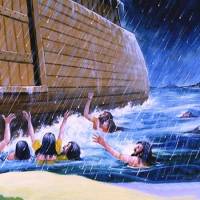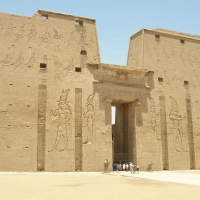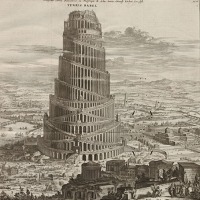Polish mathematician and astronomer Johann Kepler (1571-1630) is best known for his discovery of the laws that describe the movements of the planets. His influence on astronomy has been so great that 400 years later in 2009, NASA named a space mission for him.
Kepler saw the world as a reflection of the mind and order of God. He is credited with describing his scientific research and study of the universe as “thinking God’s thoughts after Him.” Kepler said,
“The chief aim of all investigations of the external world should be to discover the rational order and harmony which has been imposed on it by God and which He revealed to us in the language of mathematics.”
“Geometry is unique and eternal, a reflection from the mind of God. That mankind shares in it is because man is an image of God.”
Kepler believed that God had created the universe according to a logical plan that man could ascertain through the application of his reasoning powers.
Kepler calculated Creation at 3993 BC.
Sir Isaac Newton (1642–1727), discoverer of calculus and the laws of motion, was probably the greatest post-Flood scientist. He was a brilliant scientist who made ground-breaking discoveries in many fields including mathematics, classical mechanics, and optics. Newton applied the Argument from Design when he said,
“This most beautiful system of the sun, planets, and comets could only proceed from the counsel and dominion of an intelligent and powerful Being.”
– Sir Isaac Newton, Principia Mathematica (1687)
Newton, commenting on the complexity of the human eye, also said:
“Did blind chance know that there was light and what was its refraction and fit the eyes of all creatures after the most curious manner to make use of it? These and such like considerations always have and ever will prevail with mankind to believe that there is a Being who made all things and has all things in His power and who is therefore to be feared.”
(From the “Of Atheism” section in Newton’s essay A short Schem of the true Religion).
Newton wrote extensively on Biblical history. For his last 30 years to the day of his death, Newton worked on his Chronology of Ancient Kingdoms, taking it through 16 revisions. He emphatically supported Ussher’s chronology.
Newton’s calculations put Creation at 3988 BC.
Newton wrote,
“For an educated man in the seventeenth or even eighteenth century, any suggestion that the human past extended back further than 6,000 years was a vain and foolish speculation.”
(Newton, I., The Chronology of Ancient Kingdoms Amended, published posthumously 1728, cited in Renfrew, C., Before Civilization, Penguin Books, pp. 22–23, 1976.)
Two of the greatest scientists in the post-Flood history of the world, Johann Kepler and Isaac Newton, both believed the world was created around 4,000 BC.
Soli Deo Gloria.
This is the 26th in a series of blog posts on the Age of the Earth. I began with the Biblical testimony that the earth is 6,000 years old, because the evidence from nature should be interpreted and understood in the light of clear Biblical truth. The prequels have considered the issue’s importance, what Jesus thought, and the Genesis genealogies. Current posts are surveying the historic teaching of the church. Future articles will discuss scientific evidence on the age of the earth, explaining fallacies of radiometric dating methods and giving examples of scientific methods which yield short ages.
Read the prequels:
1. How Old Is the Earth?
2. Why Is the Age of the Earth Important?
3. Earth: Young or Old?
4. Age of the Earth—Jesus’ View
5. Age of the Earth—Jesus Interpreted OT Literally
6. Age of the Earth—What Did Jesus Say?
7. Age of the Earth—What Did Jesus’ Contemporaries Think?
8. Age of the Earth—Genealogies
9. Age of the Earth—What Does Begat Mean?
10. Age of the Earth—Interlocking Genealogies
11. Age of the Earth—Any Gaps in Genealogies?
12. Age of the Earth—No Gaps in Genealogies
13. Age of the Earth—Any Missing Generations?
14. Age of the Earth—Scriptural Confirmation (Adam to Noah)
15. Age of the Earth—Scriptural Confirmation (Noah to Abraham)
16. Age of the Earth—Luke’s Testimony
17. Age of the Earth—Luke & Cainan Puzzle
18. Age of the Earth—Luke & Cainan Explanation
19. Age of the Earth—Add It Up
20. Age of the Earth—6,000 Years Old
21. Age of the Earth—History’s View
22. Age of the Earth—Church Fathers’ Opinion
23. Age of the Earth—Josephus, Luther, Calvin
24. Age of the Earth—Archbishop Ussher
25. Age of the Earth—Prof. James Strong
Read the sequel:
27. Age of the Earth—Dr. William Hales
Subscribe – Don’t miss future blog posts!
Click the sidebar’s “SUBSCRIBE” button to follow the
Bible-Science Guy Blog. You’ll automatically receive
new posts free by email. Click SUBSCRIBE NOW!
©William T. Pelletier, Ph.D.
“contending earnestly for the faith”
“destroying speculations against the knowledge of God”
“for the defense of the gospel”
(Jude 1:3; 2 Cor 10:5; Phil 1:16)
Thursday September 11, 2008 A.D.
And Abram and Nahor took wives for themselves. The name of Abram’s wife was Sarai; and the name of Nahor’s wife was Milcah, the daughter of Haran, the father of Milcah and Iscah. And Sarai was barren; she had no child. And Terah took Abram his son, and Lot the son of Haran, his grandson, and Sarai his daughter-in-law, his son Abram’s wife; and they went out together from Ur of the Chaldeans in order to enter the land of Canaan; and they went as far as Haran, and settled there. And the days of Terah were two hundred and five years; and Terah died in Haran. (Genesis 11:29-32 NASB)































Let’s hope that the decision-makers at NASA don’t read this post too closely. Once they discover that Kepler was a young earth creationist, they will rename the Kepler mission, brand all of his findings as “not peer reviewed”, and vilify him posthumously.
LikeLike
By: Historicus on July 10, 2016
at 9:42 am